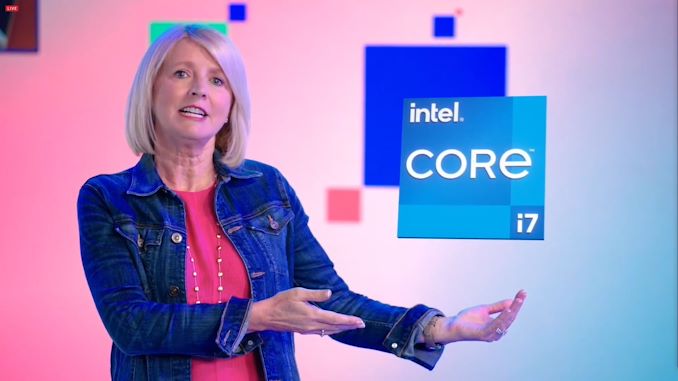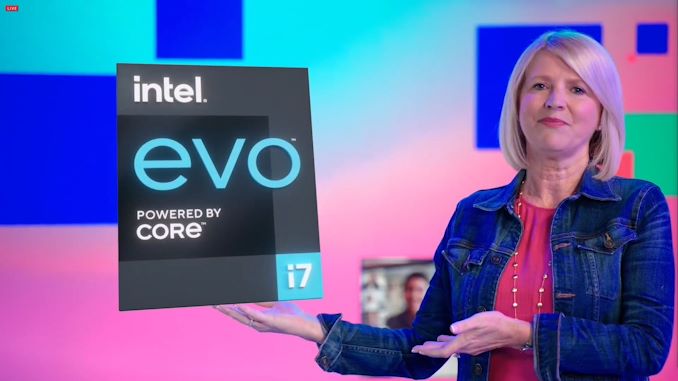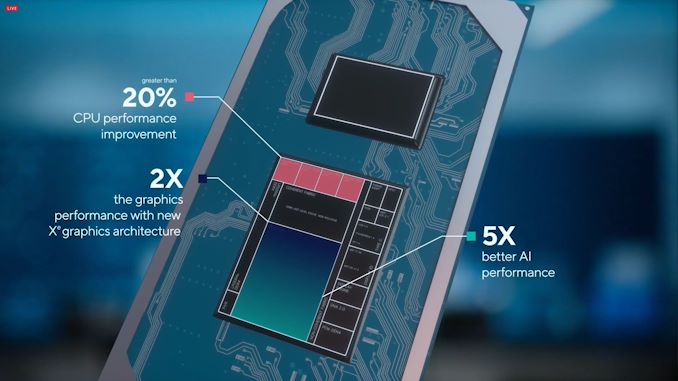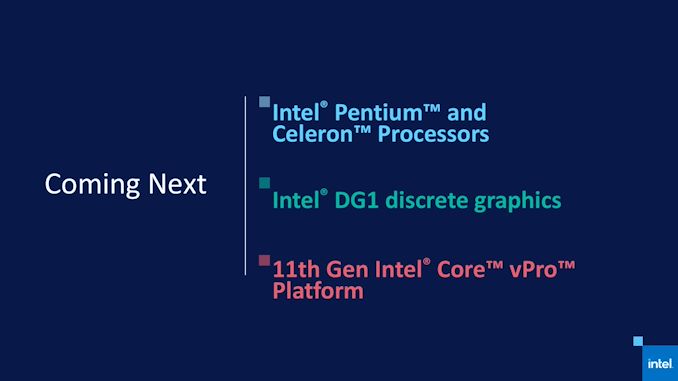Intel Launches 11th Gen Core Tiger Lake: Up to 4.8 GHz at 50 W, 2x GPU with Xe, New Branding
by Dr. Ian Cutress on September 2, 2020 12:45 PM ESTNew Branding: Intel, Intel Iris Xe, and Intel EVO
Since the introduction of Ice Lake, Intel’s logo design has seemed a bit off-kilter. The company changed how it named its processors, ditching the U and Y designations, instead of focusing on the ‘G7 and G4’ elements as well as the graphics. While those were Intel’s 10th Generation Core processors, they were categorized in a seemingly different way. Now a year later, changes are once again afoot. With the introduction of Xe graphics into the mix with Tiger Lake, the company is putting new logos and branding into the mix.
The new stickers on the laptops will look something like this. Intel has decided that its logos need to have a mix of lower case letters and capital letters for Core and Iris, despite the Intel part being in complete lower case and the ‘Graphics’ or ‘Powered By’ are all capitalized (at least it isn’t with backwards letters?). The Xe has that e in superscript as well, for the ‘eXascale for Everyone’ element of the graphics portfolio.
There is also Intel Evo, the new name for Intel’s Project Athena program, which we talk about later.
Beyond this is a full change for the Intel logo. It was stated that Intel only ever changes its logo when there is a big shift inside the industry. Today is apparently that shift, despite Intel's presentation being fairly minimal - I would have expected a logo change to occur during a large event or such. Intel says this is the third time it has fundamentally changed its logo.
Project Athena Becomes Intel Evo
With the launch of the previous generation of products, Intel introduced its Project Athena verification program. Similar to how it tried to push for ultraportable notebooks back in the day, Project Athena was a set of specifications that Intel believed were important to the premium notebook owners in the current day. This included things like minimum battery life requirements, support for Thunderbolt and Wi-Fi 6, a good display, support for AI, and a specific level of responsiveness.
In order for a laptop to be designated as a Project Athena design, it had to be validated by Intel. More often than not, Athena notebooks were co-developed with Intel anyway, making validation not much more than a formality. At the time Intel stated that Project Athena was more of an OEM standard to help push the industry along the leading edge – version 1.0 of the specification was ultimately a stepping stone to more stringent updates to the standard we learned.
Because Athena was a program designed for the OEMs rather than the customer, Intel had not necessarily worked out the marketing side of the equation. At a simple level, it was expected that these devices would, if they followed the specification, speak for themselves in offering better-than-normal user experiences equipped with the latest technology. However, at some point, we expected Athena to become end-user visible as well.
So for this Tiger Lake launch, Athena is now getting that splash of marketing, and Intel is calling any device that qualifies under the latest updates as ‘Intel Evo’. The Evo part of the name is clearly meant to be a calling to the evolution of the future generation of products.
What surprises me a bit is that the first generation of Athena was meant to be, at least on some level, CPU vendor agnostic – some of the special sauce from Intel made it easier for Intel devices to meet the specification, such as built in Thunderbolt and CNVi-based Wi-Fi 6 reduces the power consumption. With Intel Evo branding, any semblance of it being an industry-wide specification to work towards now goes out the window. While any Evo qualification is still a good thing to have, with the promise of a good user experience and the latest technology, there’s no escaping the fact that this program is now honed in for Intel-specific systems.
Intel 11th Gen Core Tiger Lake Performance
As usual, posting performance numbers isn’t really our thing – we prefer to get the hardware on hand and test for ourselves. Intel has a habit of not stating full system configurations during its presentations, and rather directing the press to look at a section on a website after the fact. To that end, we’re not going to republish reams of Intel’s own numbers here. The high level numbers that are perhaps with promoting are as follows.
When comparing an Intel Core i7-1165G7 Tiger Lake system to an AMD Ryzen 7 4800U system (both configurations unknown at this point), Intel states it has the following performance advantages:
- +28% Compute (SYSmark 25)
- +67% Graphics (3DMark Fire Strike)
- +300% AI (MLPerf)
As always, Intel’s need to promote ‘performance using real world benchmarks’ rubs up against the fact that it also posts these sorts of synthetic tests as well – especially when system configurations are no longer provided directly where the numbers are in the presentation. Intel does have ‘real world benchmarks’, directly in the next slide, but for slide #4 in a day of announcements, offering synthetics – especially ones that are known to favor Intel – is a bit frustrating. Surely an aggregate number of those real-world tests would be a better starting point for any presentation.
We will be doing our own testing when we get a Tiger Lake system in for testing.
Coming Next: Devices and Future Intel Announcements
Now that Intel’s Tiger Lake mobile processors are announced, OEM partners will also be announcing notebooks and laptops in the upcoming weeks – in fact a few will do so today. The other half of Tiger Lake still needs to be disclosed – at Architecture Day we were told that Tiger Lake scales to 65 watts, so most of us has assumed that this means a 45W to 65W range of processors, up to 8 cores, is coming. No word on that from Intel as of yet.
As a final slide from Intel’s deck, the company has clarified what to expect from its next few announcements (which we assume is from now through to the end of the year, at least from the client side of the business).
We should expect to see Intel Pentium and Celeron notebook processors later this year, along with the vPro versions of the Tiger Lake processors announced today. Perhaps more exciting is the DG1 discrete graphics platform, which is also promising to show its head. Given the recent high-end graphics announcements, it’s going to be fun playing with something more mid-range.
















348 Comments
View All Comments
Spunjji - Friday, September 4, 2020 - link
@tamz_msc "most ultrabooks come with 65W power adaptors" - firstly, no, not all. Secondly, there are other components in a system besides the CPU - add in 10W for the rest of the device's power consumption and account for conversion losses in the VRMs and you're easily approaching peak load for a 65W adaptor. Not a great situation, really.Luckily, there is literally no "ultrabook" design out there can dissipate a 50W thermal load for more than a few seconds. 30W? Sure, maybe for a few minutes. 50W? Nope. So in reality you're just going to get mediocre performance and a hot device. Yay! :|
smilingcrow - Wednesday, September 2, 2020 - link
30W is 60% of 50W which is still dramatically less so no need to exaggerate as it undermines a sense of unbiased reporting.Spunjji - Friday, September 4, 2020 - link
To quote: "As with most modern CPUs, the Ryzen 7 quickly ramps up well past its target thermal design power, hitting around 30 Watts draw at the start, but as the test goes on, that value falls back to around 18 Watts."So that's compared with a CPU that runs 50W at turbo and 28W at its quoted base clocks in order to provide comparable performance to Renoir in real-world applications. WOW.
Hifihedgehog - Friday, September 4, 2020 - link
Bingo.Hifihedgehog - Friday, September 4, 2020 - link
And all while stuck on the "quad core" standard.Kangal - Saturday, September 5, 2020 - link
Holy crap, this was the comparison I was looking for.So it seems Intel's 2021 upcoming 11th-gen is barely competing with it's 10th-gen/9th-gen/8th-gen offerings of the past. And they have nothing to compete with AMD's 2020 current Renoir. Also I think we will get only a mild upgrade from AMD's mobile for next year (still stuck on Vega, and 7nm).
So by the time Intel finally has a solution for Renoir, it's going to be late 2022. And at that time AMD will probably make a decent upgrade for their next next-gen mobile chipsets: +5nm EUV lithography, RDNA-2 iGPU, Zen3+ CPU architecture. The only question that remains is, will laptops using AMD chipsets finally get TB3/TB4/USB4 support?
It sounds like I'm beating a dead horse here, but there's still a Good Case to be made for High-Bandwidth Connection:
Just think of using your laptop as a regular Ultrabook while out and about, and when coming home you can "dock it" next to the TV (or on a Desk). Now suddenly you have much more ports, external storage, beefier active cooling for the laptops CPU, and a really fast external GPU connected. It would be like the "Nintendo Switch" but for laptops/steam.
Spunjji - Monday, September 7, 2020 - link
@Kangal I'd say you're taking it a bit far with all that. Intel and Tiger Lake are definitely *competitive* with AMD (in much the same way that Raven Ridge was competitive with Kaby Lake R), it's just interesting to see the extent to which they're bending or breaking their own prior design constraints in order to reach that level of competitiveness.It'll be interesting to see what Cezanne brings. If they add Zen 3, DDR5 and maybe bump the Vega CUs a little then it should easily reclaim the top spot for overall power/performance from Tiger Lake. Whether or not it will end up in any decent notebook designs is another matter entirely.
Kangal - Monday, September 7, 2020 - link
I beg to differ.If Intel is ready to sacrifice thermal headroom just to squeeze out more performance, well, that's not much of an improvement. It will always come at the cost of heat generated and power used up, two enemies of "mobile" devices. Maybe in a thicker laptop with large fans and a vapour-chamber, a fast charger in the box, and a huge battery... maybe in such a scenario it's not too shabby. But then using that as a comparison to a thinner laptop with cheaper/conventional cooling, regular charger, and smaller battery. Well, Intel WOULD make that comparison. To me, it is erroneous, sort of like comparing a large sedan to another small sedan, to saying thanks to "innovation" it can travel longer, with no-one commenting on the huge fuel tank size discrepancy.
To me this feels like an evolutionary iteration. Just have to cut through all the jargon to see it, it's almost obligatory that Intel, Nvidia, AMD, Apple and the like to throw these out in the presentations to impress their shareholders. The iteration is sort of like Intel going from their Core i7-6900k chipset to their Core i9-9900k. Both 8-core/16-thread, and both using the same Skylake architecture. Just one is more polished than the other. The Core i7-1185G7 (laptop flagship) feels like an incremental improvement over the i7-1065G7, i7-10610U, i7-8665U, or even the i7-8550U from +3 years ago. And looking at the Core i7-1160G7 (ultrabook flagship) it too isn't too far off from their i7-10510Y, but a notable step up from the likes of the i7-8500Y.
So my prediction from 6 months ago was kinda accurate. AMD will eventually eat into Intel's laptop (24W) dominance, but Intel is still the king when it comes to the Ultrabook (16W) market. And the tablet (8W) market is practically dead, with Android dominating the cheap-end, and iOS dominating the luxury-end. AMD still has another 1-2 iterations until they can get the recipe quite right/optimised for Ultrabooks, but I won't hold my breath, since the company is stretched very thin R&D wise.
Spunjji - Tuesday, September 8, 2020 - link
CPU-wise, it definitely is just an iteration. The innovation falls entirely on the GPU side and, supposedly, improvements to the manufacturing process. They clearly didn't get as much of a benefit as they wanted from that, though, hence the silly power levels at 4.8Ghz - but we don't yet know how that looks in terms of "average" usage (as these are clearly never going to spend long at that speed in any realistic scenarios).I think Van Gogh might be the one to watch in the 7-15W TDP arena. 4 Zen 2 cores (that can actually run close to their boost clocks) and RDNA 2 graphics might well be a healthy competitor to Intel's efforts.
Marlin1975 - Wednesday, September 2, 2020 - link
"These chips beat AMD chips that consume far more power in many benchmarks."And what are those? I have not seen any real benchmarks with true power usage for these chips. Let alone compared to AMD chips of equal footing.